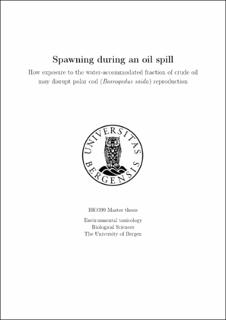Spawning during an oil spill: how exposure to the water-accommodated fraction of crude oil may disrupt polar cod (Boreogadus saida) reproduction
Master thesis
Permanent lenke
https://hdl.handle.net/11250/2986660Utgivelsesdato
2020-07-01Metadata
Vis full innførselSamlinger
- Master theses [258]
Sammendrag
Declining ice cover in the Arctic has made it possible to extract oil reserves in areas that were once unreachable. However, all oil exploration comes with an inherent risk of spills. Conditions in the Arctic may increase this risk, especially during the polar night. Key arctic fish species, polar cod (Boreogadus saida), spawns during this time. In addition, they experience low energy reserves and potentially lower food availability. If an oil spill were to occur during the polar night, exposure could lead to disruption in natural reproductive development and spawning. In the present study, wild-caught polar cod were exposed to the water accommodated fraction (WAF) of crude oil and control conditions over their spawning period at either a high or low food ration. Samples taken after 47 days of exposure showed the up-regulation of Cytochrome P450 1A (cyp1a) relative expression in exposed individuals. At the time, results indicated that gonadal development was significantly more advanced in female polar cod from exposed groups. Of the WAF-exposed females, 90 % had already spawned compared to 56 % of the controls. Moreover, there was a significant reduction in the relative expression of estrogen receptor 1 (esr1) and vitellogenin (vtgα) in exposed groups. Transcriptome mapping revealed the differential regulation of 947 hepatic genes in female polar cod. Exposure of males to the WAF did not lead to the disruption in any of the endpoints including the gonadosomatic index (GSI), testosterone (T), and 11-Ketotestosterone (11-KT). Similarly, food ration did not have a consistent effect on any of the endpoints. Contrary to the results presented, earlier studies on crude oil and petroleum compound exposure have predominately reported a delay and not an advancement in gonadal development. This difference may be explained by variations in the timing of exposure during the reproductive cycle.
